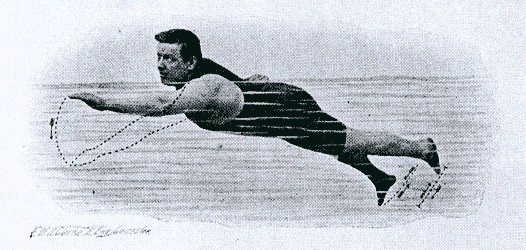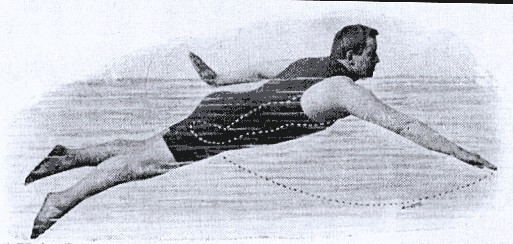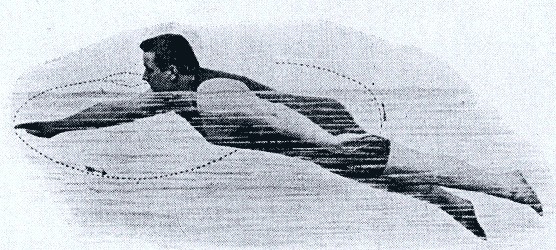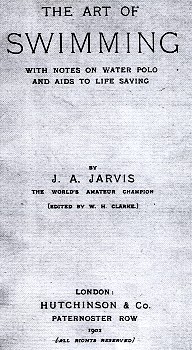 |
surfresearch.com.au
jarvis : swimming, 1902 |
| home | catalogue | history | references | appendix |
|
In Australia, after studying a female swimmer in Samoa, Sid Cavill advanced the trudgen technique by lifting the arms higher out of the water.
Initally, the arm action was seen as the critical source of propulsion and Tums Cavill demonstrated this by competing with his legs tied together.
Subsequently, Tums Cavill turned his attention to the kick in training his younger brother, Dick, who successfully used the combined propulsion sources in competition.
The style became known as the Australian Crawl, circa 1901.
The importance of
a sissors kick, vigorously breaking the water surface, would be emphatically
demonstrated by Polynesian surfrider and (untrained) swimmer, Duke
Kahanamoku, at the 1912 Olympic Games.
Page 34
His action reminds
an observer of a style parculiar to the Indians; both arms are thrown partly
sideways, but very slovenly, and the head held completely above water."
That was the
opinion of an expert of the time, and in one respect he was right, for
Trudgen won many races after that, and the peculiar metod of swimming was
named after him.
During the next
few years the stroke was practised by many swimmers with varying degress
of success, but it was not until the last three or four years that it came
into such general use, and of late vast improvements have been made in
the stroke.
In the "Badminton
Book of Swimming" the writers state:-
"It is a very
fatiguing method of progression, and rarely used for distances over 200
yards."
At that period
- 1894 - such a statement would be perfectly correct, and it was not anticipated
that it would be used for anything approaching long distances.
But all that
is altered now, for the stroke is in common use, and the favoured one with
many of the best swimmers of the present day, irrespective of the distance
that has to be covered.
In 1899 Phil
Lister swam the whole long distance course with the trudgen stroke, and
was eighth, his time being 1hr. 16min. 40secs., as compared with 1hr. 45secs.
by the winner.
This goes to
prove that the stroke can be kept up.
Then again, all
the Australian swimmers use the same stroke.
With regard to
the merits and demerits of the stroke, it all amounts to a question of
this mode of swimming can keep up their pace in the same ratio that an
over-arm swimmer does.
If that can be
done, and I think it will, then the over-arm swimmer will have to take
a secondary position in the championships of the future, becausew there
ius no doubt which is the faster of the two.
That day ...
Page 35
... will not come
at present, unless an extrodinary swimmer is unearthed, but if the improvements
made in the stroke of late years are continued in the years to come, then
I am firmly convinced that the present records at all distances will be
wiped out, and fresh ones put in their place by "trudgers."
Admittedly the
stroke is a more fatiguing one than the over-arm, but with plently of practice
this will be lessened by a man in the "pink of condition," and when the
stroke is more throughly learned and improved upon.
The person who
beats the present records will have to be a first-class swimmer, but for
all that I am certain that the trudgen stroke is the speediest of the two
if it can be maintained.
The stroke is
really a kind of double over-arm one, and the best trudgen swimmers use
a similar, though shorter, leg kick, to that made when swimming over-arm.
Starting with
the left arm straight in the water and the right arm thrown back, as in
Figure 10, the arms are brought round in a circular movement, as shown
in Figue 11, care being taken that the palms of the hands are, as far as
possible, turned way from the body.
A good idea of
the complete stroke, with regard to the arms, is offered by thye dooted
lines in Figure 12.
The leg stroke
should be short and sharp, and the top of the leg kicked well forward.
At all times
the legs should be kept as close to the top of the water as possible without
breaking through.
In practising
the trudgen stroke a swimmer should always keep well out of the water,
and the less a man rolls in using this method the better it will be for
him both as regards keeping his wind and speed.
 |
Figure 10. See page 35. Facing page 81. |
 |
Figure 11. See page 35. Facing page 96. |
 |
Figure 12. See page 35. Facing page 97. |
 |
The Art of Swimming. With Notes on Water Polo and Aids to Life Saving. The World's Amateur Champion. Edited by W.H. Clarke Hutchinson and Co. Paternoster Row, London, 1902. |

| home | catalogue | history | references | appendix |